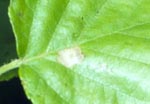Leafminers
Description

Figure 1. Birch
Leafminer Damage

Figure 1. Birch
Leafminer Damage
The adult boxwood leafminer is a tiny 1/10 inch in length, fragile, orange-yellow, gnat-like fly. The larva or maggot is yellowish-white about 1/8 inch long. The adult hawthorne leafminer is a sawfly, a bee-like insect. The larvae have flattened bodies with three pairs of legs and averages about 2/10 inch in length when fully grown.
The adult oak leafminer is a small moth. Larvae are usually about 1/10 inch long. The adult birch leafminer is a small, black sawfly about 1/10 inch long. The larva is whitish, somewhat flattened and slightly over 1/4 inch long when full grown. It has distinct black spots in the middle of the underside of the thoracic and first abdominal segments.

Figure 2. Leafminer
Damage on Honeysuckle
The adult holly leafminer is a small black fly introduced from Europe. The larva is a small yellowish-white maggot about 1/6 inch long.
Life History
Boxwood leafminer. The boxwood leafminer adult emerges in the spring when weigelia begins to bloom. The adult female begins laying eggs on the underside of young leaves inserting each egg deep into the tissues. An average of 29 eggs are laid and she dies hours after her first eggs are laid. The eggs begin to hatch in about 3 weeks and the young larvae begin feeding in the soft parenchyma tissue. Mined or blistered leaves are visible from mid summer until the following spring.The insect passes the winter as a partly grown larva in the leaves. In the spring, it become active and grows quickly. Pupation occurs in late April. There is only one generation per year.
Hawthorn leafminer. The adult hawthorns leafminer emerges on May when first leaf clusters begin to unfold and blossom buds begin to open. Eggs, 1-5 per leaf, are laid singly in the upper epidermis at the base of the leaf. The larvae feed for about 2 weeks on the parenchyma between leaf surfaces. They mine toward the distal end, generally close to the margins. By mid July they abandon the foliage, drop to the ground and construct earthen cells in preparation for winter. There is one generation per year.
Oak leafminer. The adult oak leafminer female lays her eggs on the leaf surface and each young larva bores into the leaf and proceeds to tunnel in various directions. If mining of the leaf is heavy, death of the leaf may result. Generally white and red oaks are attacked. The larvae then pupate inside the leaf and overwinter inside the dried leaves on the ground. Depending on the location and species, there may be from 2-5 generations per year.
Birch leafminer. The adult birch leafminer lay eggs singly in new leaves: Gray, paper, and white birch are favorite hosts. It rarely feeds on black, yellow, European white or river birch. Larvae feed between the upper and lower layers of the leaf forming a large hollowed-out blotch. Larval development is about 10-15 days. When mature, the larva cuts a hole through the leaf and drops to the ground. A cell is constructed in which pupation occurs. It takes 2-3 weeks for transformation into the adult stage. There may be 2-4 generations per year.
Holly leafminer. Adult holly leafminers emerge around May 1 after a few new leaves have formed. Emergence may continue over several weeks. Females lay eggs in slits on the underside of the leaves. Upon hatching, the larvae make slender, narrow mines in the leaves up to 1/2 inch in length. Later the mines broaden into a long blotch. After feeding, the larvae pupate and overwinter in the leaf. There is only one generation per year.
Damage
Leafminers cause yellow spotting of the leaves and premature leaf drop. The plants grow poorly and have sparse foliage. Repeated infestations can result in dead twigs and a weakened plant, subjecting it to disease and winter kill in colder areas. The hawthorne leafminer can be a serious pest of certain species and cultivars of Crataegus sp. From a distance heavily infested trees will have a brownish cast as though singed by fire. Injury to the tree is not long lasting, but can reduce the aesthetic quality and salability of the plant. The oak leafminer normally does not cause any serious damage to their hosts. The ornamental value may be reduced if mining is extensive. The birch leafminer is attracted to vigorously growing trees and usually these trees are able to withstand several years of attack. Most problems arise from loss of aesthetic qualities and salability of plant material. The holly leafminer causes injury to the tree both in the adult and larval stages. Adults leave tiny round feeding scars and leaf distortion results from uneven feeding punctures. With heavy infestations, every leaf can be mined causing the leaves to drop and leaving the tree practically bare until the next spring. This can be quite destructive especially in commercial orchards of "Christmas" holly. In a landscape setting excessive mining can lead to poor growth and loss of vigor. Nursery plants may not be salable if heavy infestations are present.
Nonchemical Control
Control of most miners can be achieved by burning the leaves in the fall which contain overwintering larvae or pupae.
Chemical Control
For those species that do not overwinter in the fallen foliage, chemical insecticides are available and should be applied just as the eggs are being laid on the foliage.